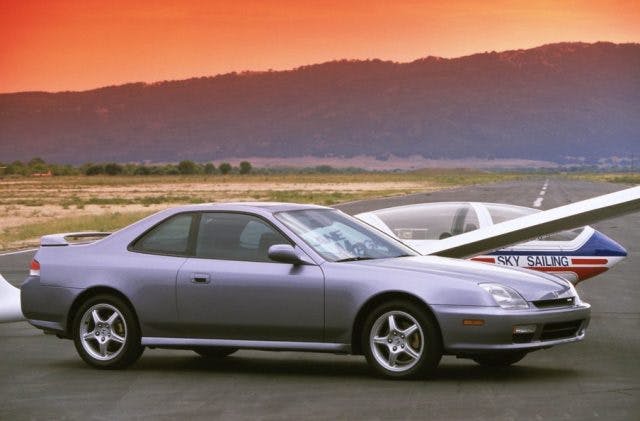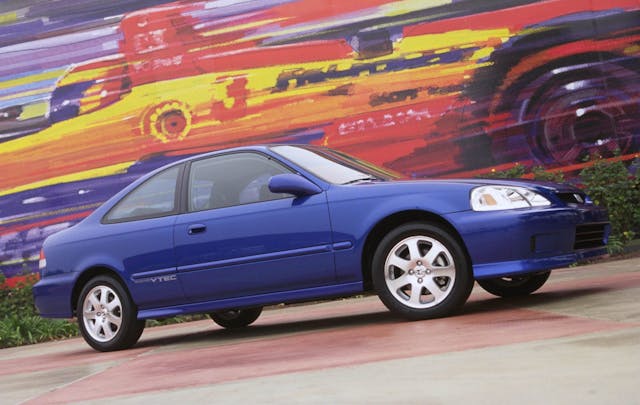Civic Si too expensive? Here are 5 cheaper, better alternatives
Don’t get me wrong: The 1999–2000 Civic Si, with its revvy engine and snappy handling, is an incredible car. But is it half-a-hundo incredible? Not so sure. A few years ago, when you could pick up a good Si for under $10 grand, it was a no-brainer. Now, though, the best low-mile cars are going for $50K and run-of-the-mill examples are nearly $15,000. Outrageous. Especially considering that EM1 Civic Si values are now a stone’s throw from those of the Acura Integra Type-R, a car that many consider the greatest front-driver ever created. Even wilder when you realize Honda made 10 times as many EM1 Civic Sis than it did ITRs.
That’s before you start thinking about the other, quicker, more exotic, non-Honda choices that are out there for the money. The whole point of the Si when new was to offer a ton of driving fun in a practical, affordable package. Once they start selling for used-Corvette money, some of the appeal fades, doesn’t it? So if you love the EM1 Civic Si (and you should) but still set yourself a reasonable budget, here are a few Japanese cars from that era that offer a similar experience but are much better buys.
This article originally appeared on Hagerty Insider.
1997–2001 Honda Prelude Type SH

Hagerty Price Guide condition #3 (Good) value: $7400
Of course this list starts with the Prelude—pun intended. Since many people shopping for classic Hondas won’t look anywhere else, I’m sure you already considered the Prelude. I’m here to convince you to give it a second look.
Honda brought out all the stops for the fifth and final Prelude generation. Though four-wheel steering wasn’t available in the U.S., as it had been on older Preludes, Honda attempted to remedy understeer with an all-new tech cheat in the Type SH trim. An acronym for “Super Handling,” the Type SH featured Honda’s new Active Torque Transfer System (ATTS) that, through a bunch of mechanical wizardry, directed more of the engine’s torque to the outside-front tire during cornering. Many period reviews praised the Type SH for its handling but claimed the ATTS wasn’t worth the extra 44 pounds; consensus held that the Type SH’s firmer springs, dampers, and antiroll bars should get more credit for the Prelude’s super handling. Either way, Honda’s engineers knocked the proverbial ball out of the park. The Type SH beat out rear-wheel-drive cars like the NA Miata and BMW 318ti in a 1997 Car and Driver handling test despite the ATTS system breaking halfway through.
In a side-by-side comparison, the Prelude isn’t far behind the Civic Si. The 2.2-liter inline-four is good for 200 horsepower (40 more than the Civic Si), which makes up for the extra weight. That extra displacement also means more torque, and every single lb-ft counts for a lot when we’re talking about VTEC Hondas. Each car will hit 60 mph in about 7 seconds, though you’ll never see 8000 rpm in the Prelude or brag about 100 horsepower per liter in the Prelude. Even though the Prelude weighs 500 pounds more, it achieved 0.83 g on a skid pad—not far behind the Civic Si’s 0.85 g. Plus, every millennial knows that the Prelude was the cooler car to have in high school. Now, they are half the price.
1990–94 Nissan Pulsar GTI-R

HPG condition #3 value: $13,300
For the same price as a Civic Si, why not buy a way cooler, quicker, and more exclusive car?
For those who don’t know about the GTI-R, buckle your five-point harness. The Pulsar GTI-R was a homologation special for Group A rallying that was designed to compete against legends like the Lancia Delta Integrale and Toyota Celica GT-Four. Though Nissan wasn’t particularly successful in Group A, never finishing better than third, the GTI-R is a hell of a hot hatch.
At the heart of the Pulsar is a unique variant of the 2.0-liter SR20DET inline-four, which sends 227 horsepower to the ground through an ATTESA all-wheel-drive system. The 2400-pound curb weight allows for a 5.4-second sprint to 60 mph and a 13.5-second quarter-mile, two whole seconds faster than the Civic Si and still speedy by today’s standards. Think of this car like a miniature Skyline GT-R. The Pulsar GTI-R also has one of the weirdest hoods ever fitted to a production car—for some reason, it reminds me of the Cave Troll from Lord of the Rings.
The GTI-R is still going unnoticed in most car circles, so promise to whisper when talking about it.
2001–05 Lexus IS300

Condition #3 value: $7500
If the whole point is to have a fun, practical car with a legendary engine—why not also get an extra set of doors? Two extra cylinders isn’t so bad, either.
Having spent the 1990s taking on (and often beating) the established German luxury cars at their own game, Lexus introduced the IS300, aiming at the gold standard of sports sedans—the BMW 3 Series. Though the IS300 never beat the 3 Series in comparison tests, Lexus proved its talents went beyond quiet, comfy cars. The IS300’s naturally-aspirated Supra-derived 2JZ 3.0-liter inline-six sends 215 horsepower to the rear wheels through an optional Torsen limited-slip differential. If that’s not enough power for you, just slap a turbo on it—Toyota engineers practically dared you to.
The 2JZ is one of the most overbuilt engines ever; you could triple the horsepower without modifying the engine’s internals. Because of this, the IS300 might be one of the only sedans to suffer from the drift tax. Low-mileage, stock examples are becoming very rare, but you can still pickup a good one with a five-speed for under $10K—if you can find it.
In stock form, the IS300 is no slouch. Despite the IS300’s 7.4-second 0–60 time (0.2 seconds slower than that of the Civic Si), it clears the quarter-mile faster—15.5 seconds at 90.0 mph versus the Honda’s 15.7 at 88.4 mph. On top of that, Motor Trend managed to run the IS300 through a 600-ft slalom at 67.6 mph. The Civic Si could only hit 65.5 mph. For icing on the cake, the IS300 has a much nicer interior. (It is a Lexus, after all.) Instead of beach towel–quality cloth, the Lexus seats are made of leather with suede inserts. Just make sure the Chronometer-style gauges don’t drive you crazy.
2000–05 Toyota Celica GT-S

Condition #3 value: $6500
The Celica GT-S was Toyota’s answer to the Acura Integra Type-R. The love-it-or-hate-it styling may turn off some, but the performance numbers should please everybody. In a 2000 Motor Trend comparison test the Celica GT-S managed to out-handle the Acura, running the 600-foot slalom at 69.1 mph compared to the ITR’s 68.2. Mind you, this was without the optional TRD suspension package, which further improved handling. The Celica also stopped from 60 mph in only 111 feet, 4 less than the Acura. The GT-S’s 1.8-liter 2ZZ inline-four, codesigned by Yamaha and made famous in the Lotus Elise, makes 180 horsepower at 7600 rpm. Good enough to rocket the 2500-pound coupe to 60 mph in 6.6 seconds—three-tenths of a second slower than the ITR, but a half-second quicker than the Civic Si.
This is arguably a better car than the Civic Si in every way. The Celica GT-S is faster, handles better, has a leather interior, comes with more power, and is still roughly the same weight. You can tout the 100-hp-per-liter title, too.
1995–99 Mitsubishi Eclipse GSX

HPG condition #3 value: $9500
The 1990s was the golden age of sporty compacts, Civic Si included, and Mitsubishi wasn’t left outside. The 2.0-liter 4G63T inline-four was turbocharged and intercooled to 210 horsepower and 214 lb-ft of torque. JDM fans might recognize that engine code from the Lancer Evo and, much like the Evo, the Eclipse GSX sends power to all four tires. The Eclipse GSX is almost like an Evo for a fraction of the price—and in a smaller package.
The GSX is a perfect example of Japan’s over-the-top car design of the 1990s. Much like its big brother, the 3000GT VR4, the GSX held nothing back. It came standard with a leather interior and had an optional limited-slip differential out back which pushed the MSRP over $27,000—and that’s in 1999 money (well over $40K today). Like many cars on this list, you’ll struggle to find stock examples. You’ll likely sacrifice some reliability compared to the Honda, but you’ll have money left in your budget for unexpected repairs. If you don’t mind sticking to front-wheel drive, look for an Eclipse GST. It has the same 210-hp engine as the GSX, but drops the AWD system and 330 pounds. You can find a good Eclipse GST for $7100.
The world hasn’t seen a car like the Eclipse GSX since it was discontinued. There’s no better example of this than the Mitsubishi Eclipse, which eventually evolved into a crossover.
The Civic Si still lives on, meanwhile, largely thanks to Honda refusing to force it to become something it wasn’t.


